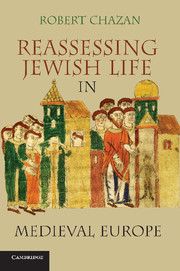Book contents
- Frontmatter
- Contents
- Acknowledgments
- Prologue: Group Narratives: Their Tenacity and Their Accuracy
- Introduction: The Emergence of Medieval European Jewry
- Part I Historical Schemes
- Part II Historical Themes
- 5 Demographic Movement and Change
- 6 Economic Activity
- 7 Status
- 8 Relations with the Christian Populace
- 9 Identity
- Epilogue: The Medieval Roots of Modern Jewish Life: Destructive Aftermath and Constructive Legacies
- Bibliography
- Index
8 - Relations with the Christian Populace
Published online by Cambridge University Press: 05 June 2012
- Frontmatter
- Contents
- Acknowledgments
- Prologue: Group Narratives: Their Tenacity and Their Accuracy
- Introduction: The Emergence of Medieval European Jewry
- Part I Historical Schemes
- Part II Historical Themes
- 5 Demographic Movement and Change
- 6 Economic Activity
- 7 Status
- 8 Relations with the Christian Populace
- 9 Identity
- Epilogue: The Medieval Roots of Modern Jewish Life: Destructive Aftermath and Constructive Legacies
- Bibliography
- Index
Summary
Assumptions of incessant jewish wandering, limited Jewish economic outlets, and debased Jewish status are important elements in the prevailing sense of the horrors of Jewish experience in medieval western Christendom. Overshadowing these negative images is the conviction that the Jews of medieval Christian Europe were the victims of unrelenting violence, grounded in historical hatred of and irrational fantasies about Judaism and Jews. For many modern observers, Jews were unceasingly the objects of assault, from the First Crusade at the end of the eleventh century and down through the close of the Middle Ages toward the end of the fifteenth century. The regular violence Jews suffered was purportedly the most devastatingly negative aspect of Jewish life in medieval western Christendom.
To be sure, it is immediately puzzling that the Jewish population of medieval Christian Europe – allegedly the most hostile of all the environments Jews have encountered – should have grown steadily throughout the period between 1000 and 1500, laying the foundation for what became the largest Jewish community in the world. Were the Christian population of medieval Europe implacably hostile to Jews and were violence in fact a constant of Jewish life, it would be difficult indeed to account for the ongoing Jewish population growth. A community exposed to unceasing hostility and violence would not have opted to remain in such a destructive environment and would not have enjoyed the demographic growth that eventually produced the world's largest Jewry. Steady Jewish population growth should at least raise some doubts about the widely purveyed sense of intense and constant anti-Jewish violence during the course of the European Middle Ages.
- Type
- Chapter
- Information
- Reassessing Jewish Life in Medieval Europe , pp. 158 - 192Publisher: Cambridge University PressPrint publication year: 2010



